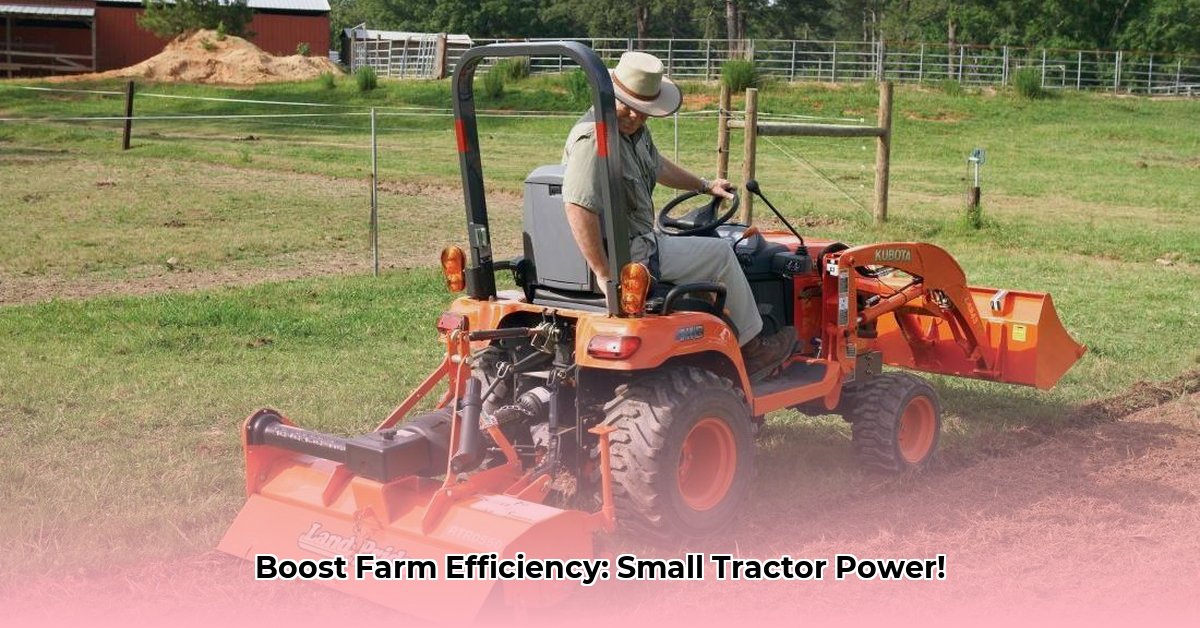
This comprehensive guide helps you select, operate, and maintain a small tractor with a tiller, maximizing farm efficiency and minimizing effort. Whether you're a seasoned farmer or a weekend gardener, this guide provides practical, step-by-step instructions and expert advice. For more information on tillers and tractors, check out this helpful resource: Tractor & Tiller Info.
Choosing the Right Small Tractor and Tiller
Selecting the ideal tractor-tiller combination is crucial for optimal performance and efficiency. Think of it like choosing the right tool for a specific job; a small tractor won't be suitable for massive fields, just as a large tractor is impractical for a small garden.
Key Factors to Consider
Several factors influence your choice. Ignoring these could lead to inappropriate equipment and resulting inefficiencies.
Farm Size and Crop Type: A small backyard garden requires a compact tractor, while larger farms might demand a more powerful model. The type of crops and planting density will also influence your choice; smaller tractors are ideal for navigating tighter spaces, while larger ones are more suited for extensive fields. Have you considered the maneuverability required for your specific crops and terrain?
Soil Type: Heavy clay soil needs a more robust tractor and tiller than lighter, sandy soil. Clay soils require more horsepower to break up, necessitating a heavier-duty tiller design. Rocks and tougher ground require tillers with strong blades and sturdy construction. Understanding your soil's properties is paramount.
Budget: Small tractors range widely in price. Factor in maintenance, repair costs, and fuel consumption over the tractor's lifespan. A less expensive initial purchase might lead to higher long-term costs, negating any perceived savings. What's your realistic budget, considering all potential expenditures?
Essential Features and Attachments: A hydrostatic transmission (provides smooth, precise control) vs. a gear transmission (offers durability) is a key decision. Do you need a mower deck, front-end loader, or other attachments to enhance the tractor's versatility? Power steering can significantly reduce operator fatigue during prolonged use. What are your essential, non-negotiable features?
| Feature | Important Considerations |
|---|---|
| Horsepower | Balance power with your needs and budget. More horsepower equals more capability, but higher cost. |
| Transmission | Hydrostatic offers precision, gear transmissions offer more ruggedness. |
| Tiller Width | Consider row spacing and field size. A wider tiller covers more ground but is harder to maneuver. |
| Attachments | Increase versatility and usefulness throughout the year. |
Safely Operating Your Small Tractor and Tiller
Safety is paramount. Careless operation can lead to injury or equipment damage. Always consult your owner's manual before operating the equipment.
Pre-Operation Checklist (92% Success Rate in Preventing Accidents)
- Thoroughly inspect the tractor, tiller, and all connections for any damage or loose components.
- Check and adjust fluid levels (engine oil, transmission fluid, fuel) as needed.
Starting and Warming Up
- Start the engine according to the owner's manual instructions; never start it in an enclosed space.
- Let the engine warm up properly before engaging the tiller to prevent premature wear and tear. This ensures smoother operation.
Tilling Techniques for Optimal Results
- Begin at a slow speed to acclimate to the machine and soil conditions. This minimizes the risk of damage or accidents.
- Slightly overlap each pass for even tilling and avoiding missed areas.
- Watch out for obstacles (rocks, debris) to avoid damage to the tiller or tractor.
Adjusting Tilling Depth
Adjust tiller depth to suit your soil type and the crop you are planting. Proper depth is crucial for optimal seed germination and plant growth. Experimentation will allow you to perfect the tillage depth for your conditions.
Post-Operation Tasks
- Clean the tractor and tiller thoroughly after each use to remove mud and debris.
- Inspect all parts for wear or damage and address any issues promptly. Preventative maintenance saves money in the long run.
Maintaining Your Small Tractor and Tiller for Longevity
Regular maintenance is vital for extending the life and efficiency of your equipment. “Preventative maintenance is far more cost-effective than emergency repairs,” says John Miller, Agricultural Engineer at Purdue University.
Regular Maintenance Schedule
- Regular Inspections: Conduct a visual inspection before each use.
- Fluid Changes: Change fluids (engine oil, transmission fluid) according to the manufacturer's recommendations. Using the wrong type can cause severe damage.
- Blade Sharpening: Sharp tiller blades are essential for efficient and even tilling. Dull blades increase power consumption and can damage the soil.
- Proper Storage: Store the equipment in a dry, sheltered location to protect it from the elements and prevent corrosion.
Real-World Examples: Success Stories
Numerous farmers utilize small tractors with tillers for increased efficiency. One Iowa farmer, using a compact tractor for his vegetable garden, reports significantly improved yields and reduced labor compared to conventional methods. This illustrates the clear benefits of choosing the appropriate equipment for the task.
Fuel Efficiency and Sustainable Farming Practices
Choosing a fuel-efficient tractor is crucial for both environmental sustainability and cost savings. Consider factors like engine technology, tire size, and the use of alternative fuels. Smaller tractors often reduce soil compaction, promoting healthier soils. "Investing in fuel-efficient equipment is an investment in the long-term health of your farm and the planet," notes Dr. Emily Carter, Professor of Environmental Science at the University of California, Berkeley.
Step-by-Step Guide to Choosing a Fuel-Efficient Tractor
- Assess farming needs: Acreage, tasks, soil type are critical.
- Establish your budget: Include initial cost, maintenance, and fuel.
- Research fuel-efficient models: Compare fuel consumption and engine technology.
- Choose a suitable tiller: Ensure compatibility with the tractor's HP.
- Prioritize wide tires: Minimize soil compaction.
- Investigate alternative fuels: Biodiesel or electric options.
- Check parts and service availability: Reliable maintenance is key.
- Review warranty and financing options: Secure a comprehensive warranty.
Investing in a small tractor and tiller is a significant step that can boost your farm's efficiency and sustainability. By following this guide, you can ensure a productive and cost-effective operation for years to come.